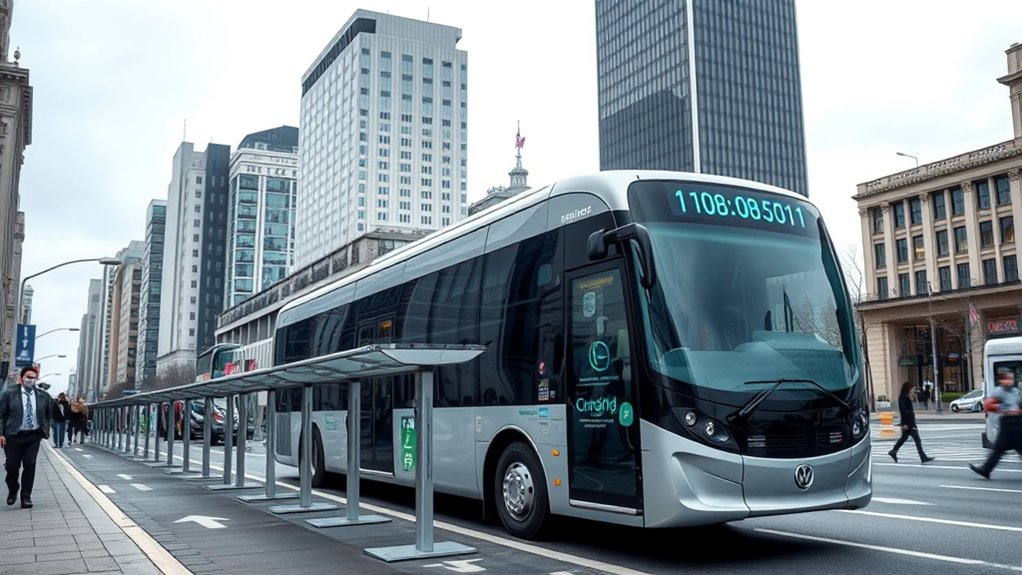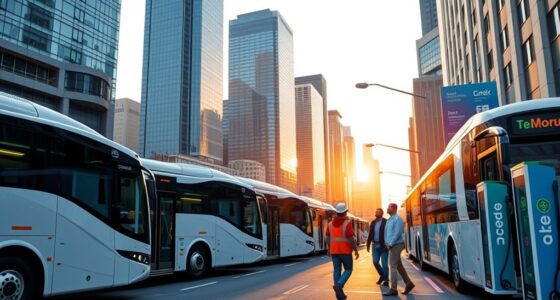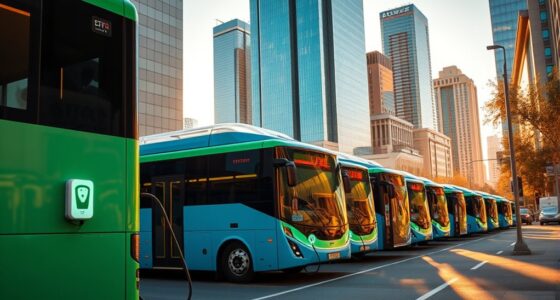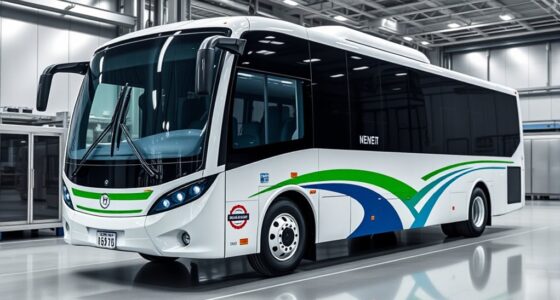The COVID-19 pandemic initially disrupted the electric bus market by causing supply chain shortages, factory shutdowns, and delays in manufacturing and delivery. However, government policies, incentives, and investments in infrastructure helped promote recovery and growth. Advances in battery technology and sustainability initiatives further boosted the industry’s resilience. As restrictions eased, demand rebounded, and the market expanded considerably. To understand how industry players adapted and what the future holds, keep exploring these critical developments.
Key Takeaways
- Supply chain disruptions caused raw material shortages and manufacturing delays, impacting electric bus production and delivery schedules.
- Market resilience was supported by government policies, incentives, and investments in charging infrastructure during the pandemic.
- Demand rebounded post-lockdowns, fueling industry growth from USD 29 billion in 2021 to an estimated USD 106 billion by 2028.
- Smaller industry players faced funding shortages, slowing component production and affecting overall market stability.
- Continued technological innovation and supply chain diversification are key to long-term recovery and sustainable growth.
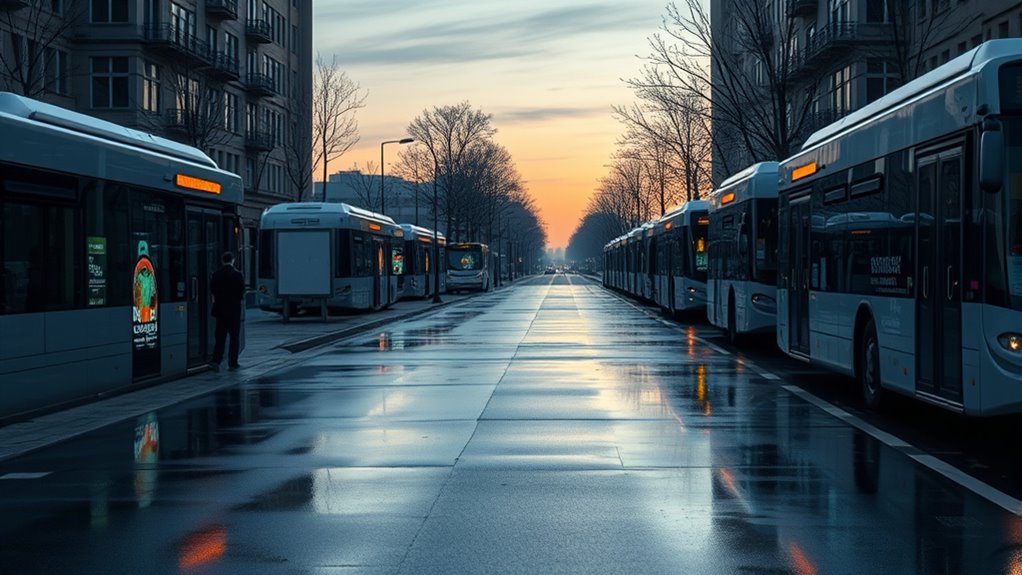
The COVID-19 pandemic has considerably affected the electric bus market, disrupting supply chains, halting manufacturing, and shifting demand patterns. When the virus first spread globally, supply chain breakdowns became a major obstacle. You’d find raw materials and critical bus components suddenly scarce, making it difficult to keep production lines running smoothly. Manufacturers faced delays not only because of shortages but also due to lockdowns that temporarily shut down factories worldwide. These interruptions slowed down the assembly of electric buses, leading to delays in deliveries and affecting market supply. Logistics and transportation services also faced disruptions, further complicating deliveries and increasing costs. This combination of supply chain issues created a ripple effect, hampering the industry’s overall growth during the initial stages of the pandemic.
Despite these setbacks, the market showed resilience thanks to proactive government support. You’d see many governments stepping in with regulations and incentives aimed at boosting electric bus adoption. Policies like tax benefits, subsidies, and investments in charging infrastructure helped mitigate some pandemic-related challenges. These measures encouraged manufacturers and buyers to continue investing in electric buses, aligning with broader environmental and sustainability goals. The increased focus on sustainable transportation has helped accelerate industry recovery and growth. Additionally, the industry is exploring new supply chain diversification strategies to prevent future disruptions and ensure steady growth.
Governments’ incentives and policies boosted electric bus adoption despite pandemic setbacks.
As restrictions eased, the market began to recover, and demand started rebounding, especially as economies looked for ways to stimulate growth and modernize transportation systems. The increasing adoption of high-efficiency solar panels for charging infrastructure has also played a role in supporting the sustainable growth of electric bus fleets. Additionally, advancements in battery technology have improved vehicle range and reduced costs, further encouraging adoption. The ongoing development of recycling methods for batteries is expected to further enhance sustainability efforts in the industry.
The economic slowdown caused by the pandemic also impacted the industry financially. Smaller Tier II and Tier III companies struggled with funding shortages, which slowed component production and limited their ability to meet market demand. Meanwhile, overall demand for public transportation declined temporarily due to safety concerns and reduced mobility during lockdowns.
However, governments and industry players recognized electric buses as part of their economic recovery strategies, emphasizing sustainable transportation options to promote long-term growth. This shift helped the market regain momentum, with the valuation rising from USD 29 billion in 2021 to an estimated USD 106 billion by 2028.
Experts project a compound annual growth rate (CAGR) between 16% and 20% during this period, reflecting confidence in the industry’s future despite early pandemic disruptions.
Looking ahead, the market’s growth is supported by ongoing investments in infrastructure, technological innovation, and regulatory support. While supply chain diversification remains a priority to reduce vulnerabilities, the industry is adapting to new realities.
Demand for electric buses is poised to increase as post-pandemic recovery accelerates and environmental regulations tighten. Overall, although COVID-19 temporarily slowed down the growth trajectory, it also prompted industry players to innovate and adapt, laying the foundation for a robust, sustainable transportation future.
Frequently Asked Questions
How Have Consumer Preferences Shifted Toward Electric Buses During the Pandemic?
You notice that consumers now prefer electric buses more than ever, mainly because they’re environmentally friendly and help reduce urban pollution.
You see that increased awareness of their benefits, along with government support and technological improvements, makes electric buses more appealing.
Despite some supply chain issues, your interest grows as the market is expected to expand, driven by sustainability goals and advancements in electric vehicle technology.
What Long-Term Strategies Are Manufacturers Adopting Post-Covid-19?
You should focus on long-term strategies manufacturers are adopting post-COVID-19, like expanding production capacity and investing in sustainable growth. They’re also diversifying their offerings with multi-technology approaches and targeting niche markets to stay competitive.
Emphasizing innovation, such as advanced batteries and vehicle-to-grid systems, helps reduce costs and improve efficiency.
Collaborating with governments and private partners guarantees continued funding and support, securing their position in the evolving electric bus industry.
How Has Government Policy Changed in Response to Pandemic Challenges?
You’ll notice that government policies shifted to support electric bus adoption during the pandemic. They relaxed compliance timelines and approved new models faster to resume market activity.
Additionally, they provided subsidies, grants, and tariffs waivers to ease supply chain issues. Public-private partnerships expanded, and safety measures like contactless payments and driver retrofits became priorities.
These changes aim to stabilize the market and promote sustainable transit, even amid ongoing health challenges.
What Are the Supply Chain Disruptions Specific to Electric Bus Components?
You might think supply chains are smooth sailing, but COVID-19 proved otherwise. You face disruptions in sourcing key components like lithium, cobalt, and nickel, as imports grind to a halt.
High-value parts like separators and IGBTs hit bottlenecks, driving prices up and causing delays. Ironically, efforts to find local substitutes and diversify sources only highlight how fragile the global supply network truly is.
How Is Funding for Electric Bus Projects Affected by Economic Recovery Efforts?
You’ll notice that funding for electric bus projects increases as part of economic recovery efforts. Governments allocate recovery funds and subsidies to promote clean transportation, especially focusing on zero-emission vehicles.
These investments aim to modernize transit, meet environmental goals, and stimulate local economies. By prioritizing infrastructure and fleet upgrades, you’ll see more financial support for e-bus projects, encouraging broader adoption and long-term sustainability in the transit sector.
Conclusion
While COVID-19 initially disrupted the electric bus market, forcing delays and setbacks, it also accelerated innovations and investments in green transportation. You might think the pandemic slowed progress, but it actually pushed the industry to adapt faster and prioritize sustainability. Just as the virus challenged mobility, it sparked a renewed push toward cleaner, smarter transit solutions. In this contrast, you see how adversity can ignite opportunities, shaping a more resilient and eco-friendly future for electric buses.
